Rich media ads are a type of online display advertising that goes beyond the traditional banner or text ads by incorporating more interactive and engaging elements such as videos, animations, audio, and other multimedia features.
Rich media ads are designed to grab the viewer's attention and provide a more immersive and memorable advertising experience, leading to higher engagement rates and better campaign performance.
It can be delivered in various formats, including expandable banners, interstitials, in-stream interactive video ads, and mobile ads.
While text ads promote a product using words, display ads sell it through the use of pictures. On the other hand, rich media ads offer a broader range of options to engage an audience with advertisements.
Rich media ads offer several advantages over traditional banner ads, such as increased engagement, improved brand awareness, higher click-through rates, and better conversion rates.
It is also more effective in conveying complex messages and building emotional connections with the audience.
However, rich media ads can be more complex and expensive to produce than standard ads and require more resources and technical expertise.
Let's find out what it is and how rich media ads work.

Rich media ad formats
Interactive formats are important today because users are tired of advertising — it's everywhere. They need to be engaged so that they really remember the brand or product being advertised. This works especially well in brand or product awareness campaigns.
Advertisers can use several rich media ad formats to engage with their audiences. Some of the most popular rich media ad formats include:
Expandable Banners
This type of rich media ad typically starts as a standard banner ad, but when the user hovers over the ad or clicks on a specific call-to-action button, the rich media ad expands to reveal additional content, such as a video or image gallery.
Rich media banner ads are designed to be more engaging and interactive than traditional banner ads. They allow advertisers to provide more information about their products or services without taking up too much space on the web page or the website.
Additionally, the interactive nature of expandable banners can help increase engagement and click-through rates, leading to better campaign performance.
There are two types of expandable banners:
Click-to-expand
Rich media banner ads expand when a user clicks on a specific button or link within the banner. This type of ad is often used to provide more information about a product or service or to offer a special promotion.
Hover-to-expand
Rich media banner ads expand when users hover over the banner with their cursor. This type of ad is often used to create a more subtle and interactive experience for the user.
Interstitial Ads
Interstitial ads are a type of digital advertisement that appears as a full-screen ad that covers the entire screen of a device, often between transitions during content or app usage.
These rich media ads are typically designed to be engaging and attention-grabbing. They often include rich media elements such as videos, images, or interactive features like quizzes, games, or surveys.
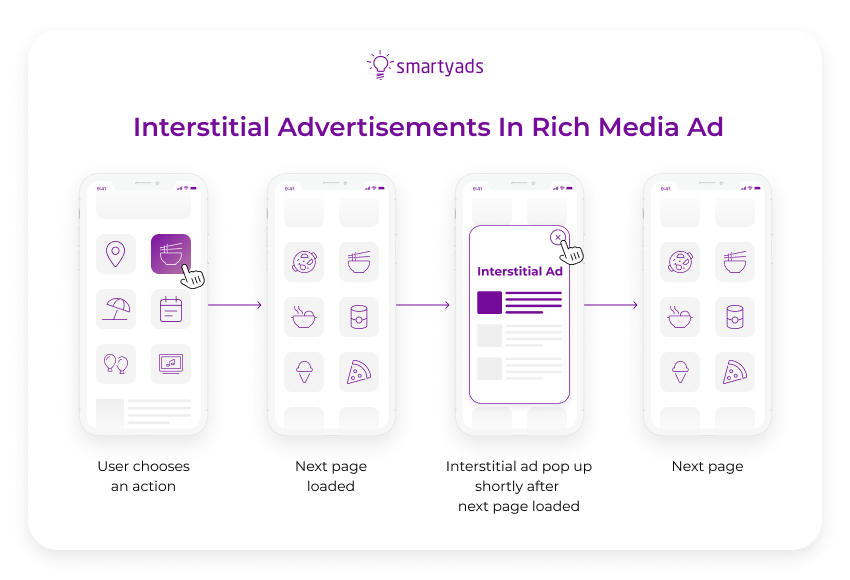
These are full-screen ads that appear between content on web pages or during natural transition points in mobile apps. They can include interactive features, such as video or gaming elements, to engage the user.
In-Stream Video Ads
In-stream video ads are a type of digital advertising that appears within a video player, typically before, during, or after the main video content. They are designed to capture the viewer's attention and create a more engaging and immersive ad experience.
In-stream video advertising can be either skippable or non-skippable, and it may include interactive features such as overlays, call-to-action buttons, or social sharing buttons.
Skippable video ads allow the viewer to skip the ad after a few seconds, while non-skippable ads require the viewer to watch the entire ad before returning to the main content.
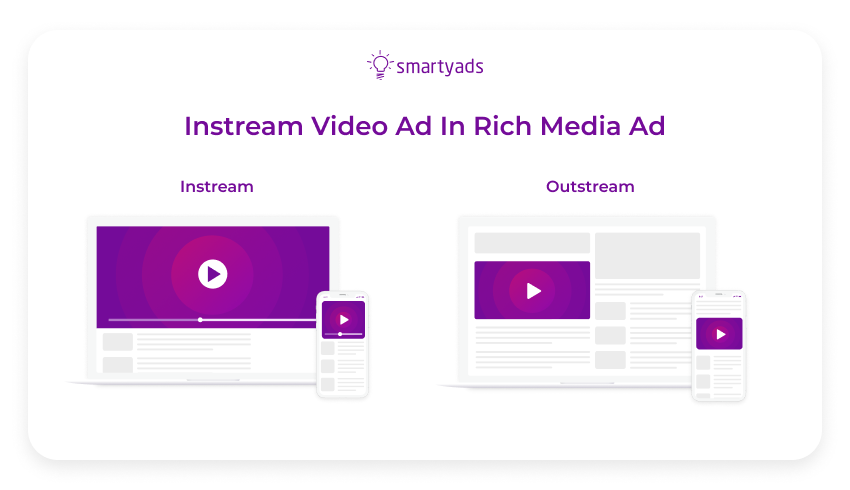
In-stream video ads are popular because they offer a highly engaging and immersive advertising experience that allows advertisers to deliver their message to a captive audience.
They can be used to promote a wide range of products and services and can be targeted to specific demographics and interests.
One potential disadvantage of in-stream video ads is that they can be costly to produce and distribute. Additionally, viewers may find them intrusive, negatively impacting their viewing experience.
However, with careful planning and targeting, in-stream video ads can effectively reach and engage with a highly targeted audience.
Mobile Rich Media Ads
Rich media mobile ads are a type of digital advertising designed specifically for mobile devices, taking advantage of the unique features of smartphones and tablets, such as touchscreens, GPS, and accelerometers.
These ads often include interactive features that encourage users to engage with the ad and can provide a more captivating and memorable experience than standard banner ads.
Rich media mobile ads can take various forms, including banner ads, interstitial ads, and in-app ads.
They can incorporate various interactive elements, such as swipeable image galleries, location-based offers, and click-to-call buttons.
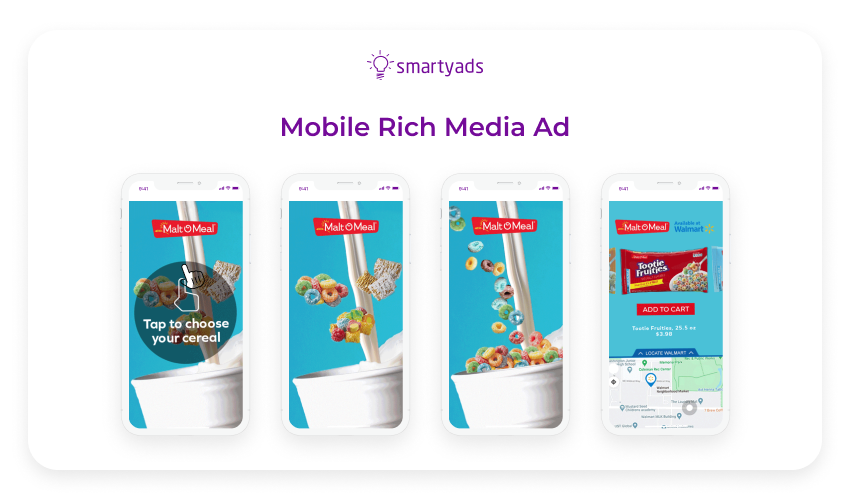
They can also include video, audio, and other multimedia elements to make the ad more engaging and interactive.
One advantage of rich media mobile ads is that they can be highly targeted to specific demographics and interests, allowing advertisers to reach their desired audience more effectively.
Additionally, because mobile devices are typically used for on-the-go activities, such as browsing social media or using apps, mobile ads can capture a user's attention more effectively than ads on other devices.
Interactive Ads
Interactive ads are a type of digital advertising that engages users in a two-way communication process rather than just presenting a static message.
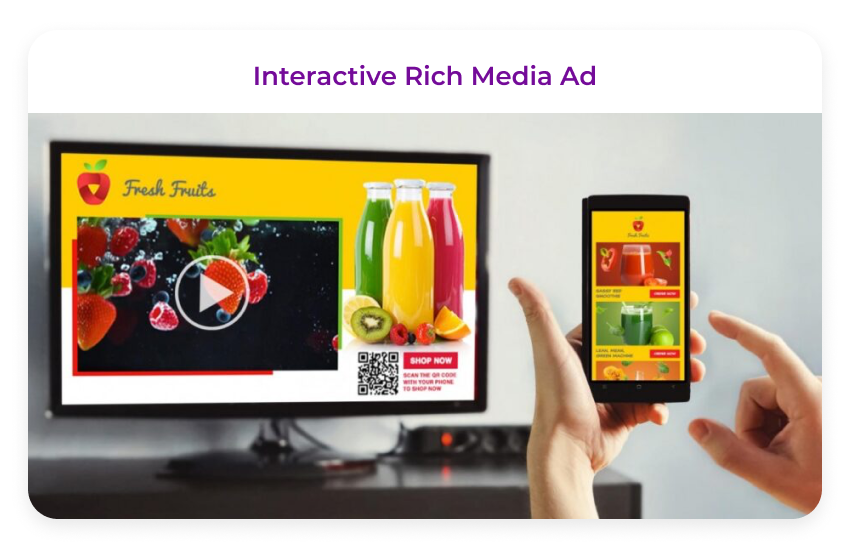
These ads encourage users to interact with the ad content in some way, such as by clicking on a call-to-action button, filling out a form, or playing a game.
Interactive ads can take many forms, such as quizzes, polls, games, and augmented reality experiences.
They are designed to be engaging, fun, and memorable and can help advertisers create a more immersive advertising experience that connects with users on a deeper level.
One advantage of interactive ads is that they can be more effective at capturing users' attention than traditional ads. Because they require user interaction, they can be more engaging and entertaining, leading to better brand recall and increased user engagement.

How to create Rich media ads
To create rich media ads, you'll need some technical skills and creativity, but the process can be broken down into a few key steps:
Define your goals
Before creating your ad, you need to define your goals and objectives. What do you want to achieve with your ad? Who is your target audience? What message do you want to convey? Answering these questions will help you create an ad tailored to your specific needs and objectives.
Choose the right ad format
Types of rich media ads include expandable banners, interstitial ads, in-stream video ads, and more. Choose the format that is best suited to your goals and target audience.
Create your ad content
Once you have chosen your ad format above, it's time to create your ad content. This may include images, videos, animations, interactive elements, and other multimedia features. Consider using a mix of different elements to create an engaging and dynamic ad.
Design your ad
Use a design tool or work with a designer to create your ad's visual layout and design. Consider the size, color scheme, typography, and other design elements to make your ad stand out and capture the viewer's attention.
Add interactivity
Consider adding interactive elements such as clickable buttons, video players, and other interactive features to make your ad truly rich media. These elements will engage the viewer and make your ad more memorable and effective.
Test and optimize
Before launching your ad, test it on different devices and platforms to ensure it works properly and looks great on all devices. Use data and rich media tracking systems to track the performance of your ad and optimize it for maximum effectiveness.
Examples of rich media ads
We've put together some examples of rich media ads for your inspiration and to better understand how such creatives can work.
IKEA rich media ads
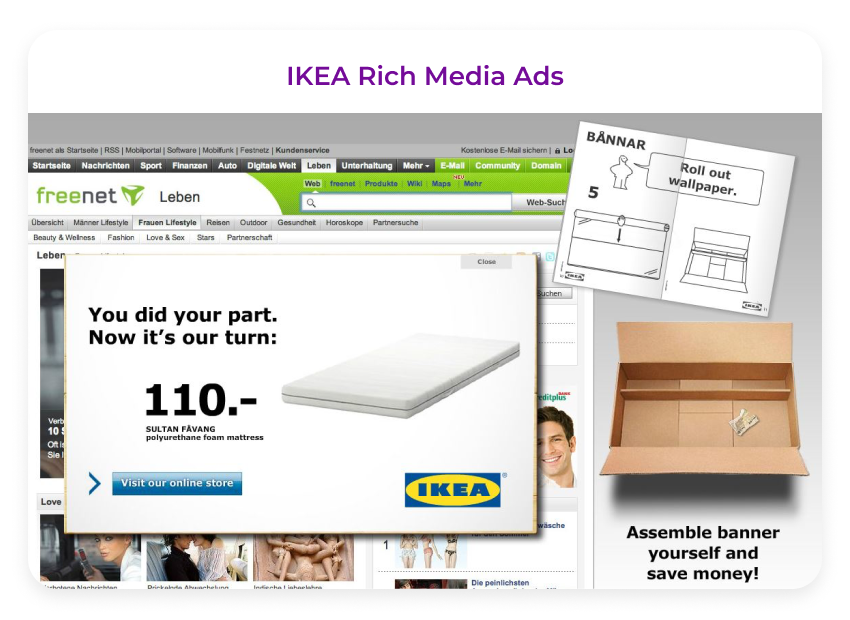
IKEA created a banner that the user has to compile themselves. This kind of banner is not only perfect for the company (who among us is not familiar with the famous instructions for assembling furniture from IKEA) but also perfectly provokes user interaction with the advertising content.
When a user pays attention to an ad and takes the action you demanded of them, you can give them a discount or bonus to make up for the effort.
Netflix rich media ads
This ad includes a unique video from the actors and is presented almost like a trailer.
If you hover over the image, you will see rotating moving images. In addition, if you click on the ad, you can watch the actual trailer of the Netflix show. This is a great multimedia ad that incorporates several multimedia ad formats to engage the viewer.
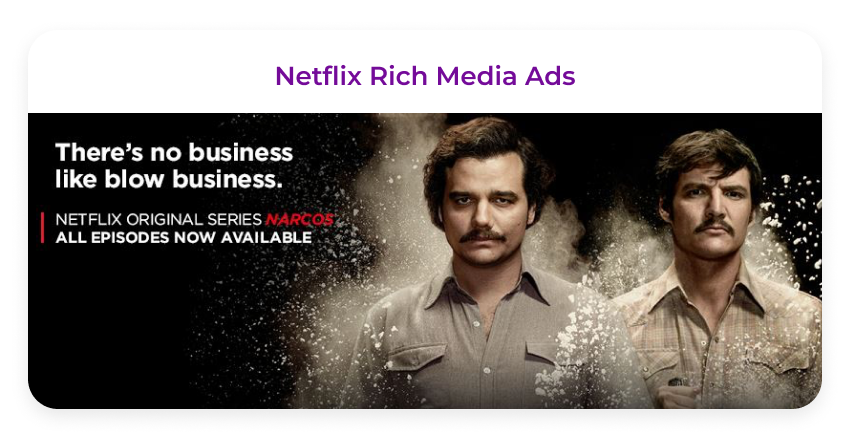
Additional factors in attracting attention, of course, are the stars of Netflix shows. Still nevertheless, the interactive format also plays a huge role in the success of such an innovative ad campaign.
Samsung in Spain — Smart TV rich media ads
Advertisements show that the user can control the TV with a smartphone. The smartphone can replace the remote control.
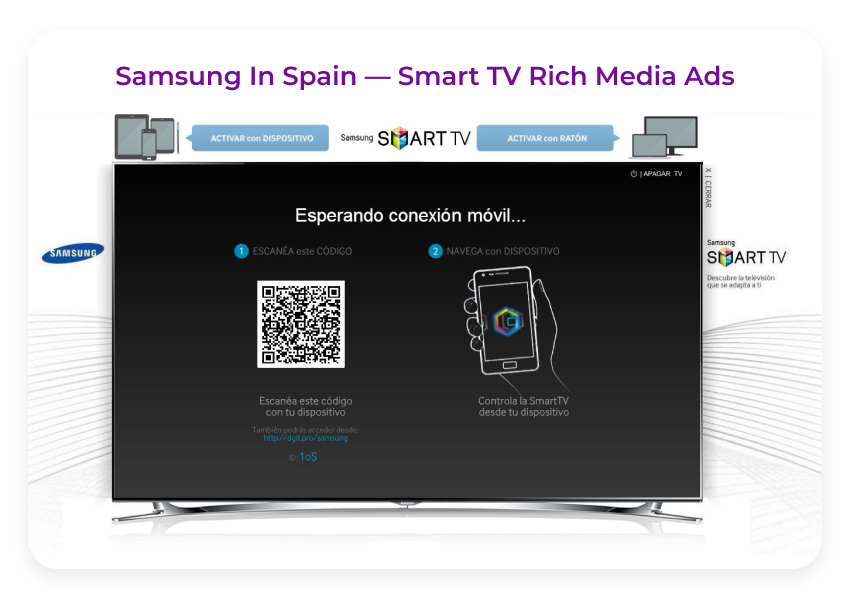
Thinking about it, when watching TV, we almost always either have our phone in our hands or somewhere nearby. The marketers at Samsung decided to take advantage of this knowledge, and they had a great and successful ad.
The Hobbit's rich media ads
In this case, it is not a standard banner ad but a whole landing web page written in HTML5 (that is, supported by (almost) every mobile device and specially formatted for tablets). The reason for choosing this format is quite simple: it allows you to show the story advertisers want on mobile devices.
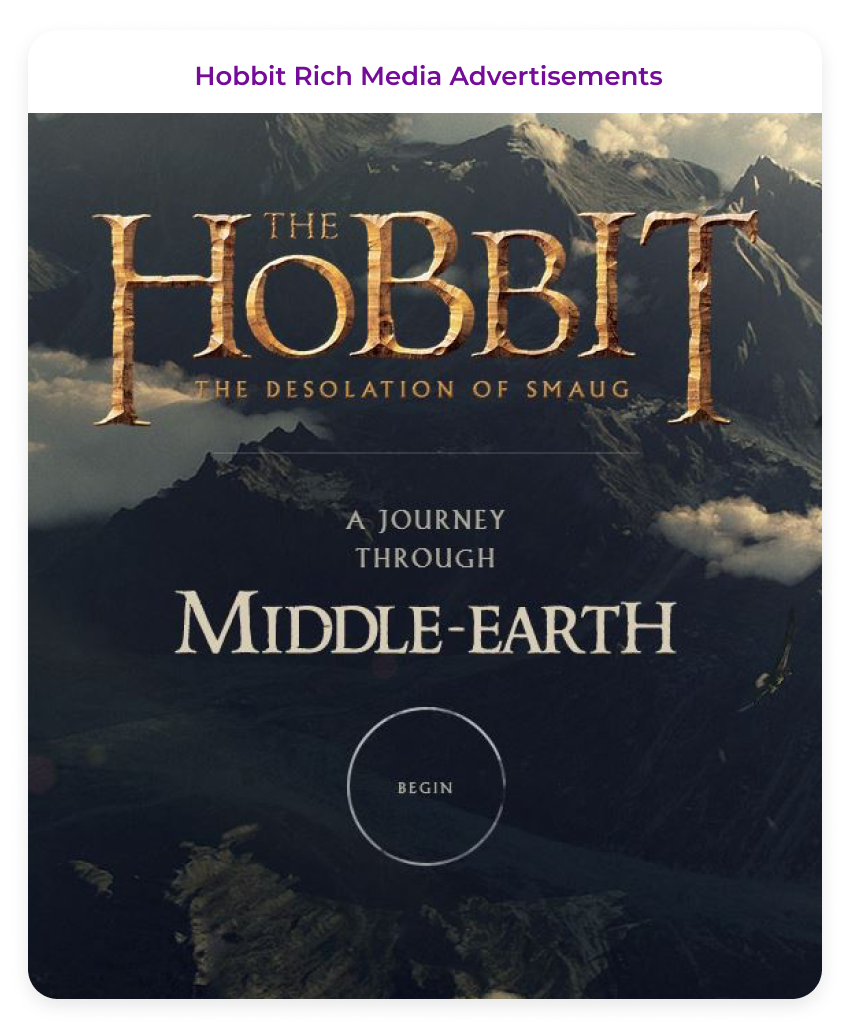
This performance of the movie "The Hobbit" will guide you through the storyline and characters in a very familiar user gesture style optimized for mobile devices.
Benefits of using Rich Media ads
Rich media opens up several hidden opportunities for advertisers. It's a tool that allows you to reach previously inaccessible audiences and a tool that can dramatically improve your brand awareness when used correctly.
Let's take a look at the key benefits of using rich media.
Increased Engagement
Obviously, multimedia ads are more engaging than static, or text ads sell because they can capture a user's attention through motion, sound, and interactive elements. Increased engagement can lead to more clicks and, ultimately, more conversions.
Improving brand awareness
Because of their interactive and engaging nature, ads with multimedia technologies are more likely to be remembered by consumers. They can help reinforce your brand message and create stronger brand recall.
More precise targeting
Multimedia advertising allows for more precise ad targeting because it can be customized based on user behavior, interests, and demographics.
This can help improve the relevance of your ads and increase their effectiveness.
Increased sharing
Rich media ads are more likely to be shared on social media platforms because they are visually appealing and interesting.
This will help increase your campaign's reach and brand awareness.
Improved Storytelling
Multimedia advertising allows for more creative storytelling because it can incorporate different multimedia elements to convey your brand's message.
This will help create a more emotional connection with your audience and improve the campaign's overall effectiveness.
Reach Media Ads Challenges
Although rich media is a useful and potentially very promising tool, there are also some potential drawbacks.
Complexity
Rich media ads are more complex to create than static ads, as they require more resources and technical expertise.
This can lead to higher production costs and longer lead times.
Load timing
Rich media ads can take longer to load than static ads, leading to a slower user experience.
This can be particularly problematic for users on slower Internet connections or mobile devices.
Compatibility
Rich media ads may not be compatible with all devices or browsers, which can limit their reach.
Ensuring your ads are compatible with the most commonly used devices and browsers is important.
Ad blockers
Some users may have ad blockers installed on their devices, which can prevent rich media ads from being displayed.
This can limit the reach of your ad campaign and reduce its effectiveness.
User experience
If ad campaigns are not executed properly, rich media ads can be intrusive and disrupt the user experience.
This can lead to a negative impression of your brand and decreased engagement.
However, suppose you consider all the possible risks in advance and adapt your advertising campaigns to the current capabilities of technology and the specifics of the geo in which you will run these ads. In that case, everything will be just fine. Risks are not scary when you know all about them.
To sum it up
Rich media advertising is not a new type of advertising technology. Instead, it consolidates many proven and well-known advertising tools into one even better and more effective one.
Rich media enables advertisers with a platform for increased innovation, offering ample space for experimentation with imaginative and original concepts that can greatly enhance brand recall and awareness.
The further the technologies develop, the more possibilities for advertisers to create such complicated interactive advertisements.
All these changes are extremely interesting to track, but even more interesting to use in practice, as they bring real benefits to brands.
If you want to run your rich media ads, don't hesitate to contact us!
FAQ
Rich media ads incorporate interactive elements such as videos, animations, and audio, offering a more engaging experience compared to static display ads. This interactivity can lead to higher user engagement and improved brand recall.
Yes, consider the following: Ensure fast loading times to prevent user frustration. Design for mobile responsiveness, as many users access content via mobile devices. Maintain a balance between creativity and clarity to convey your message effectively.
While rich media ads can enhance engagement across various sectors, their effectiveness depends on the target audience and campaign objectives. Industries like fashion, entertainment, and technology often see significant benefits, but it's essential to tailor the approach to your specific audience.
For a streamlined experience, platforms like SmartyAds DSP allow advertisers to manage, target, and optimize rich media campaigns in one place, giving you access to a wide range of inventory.

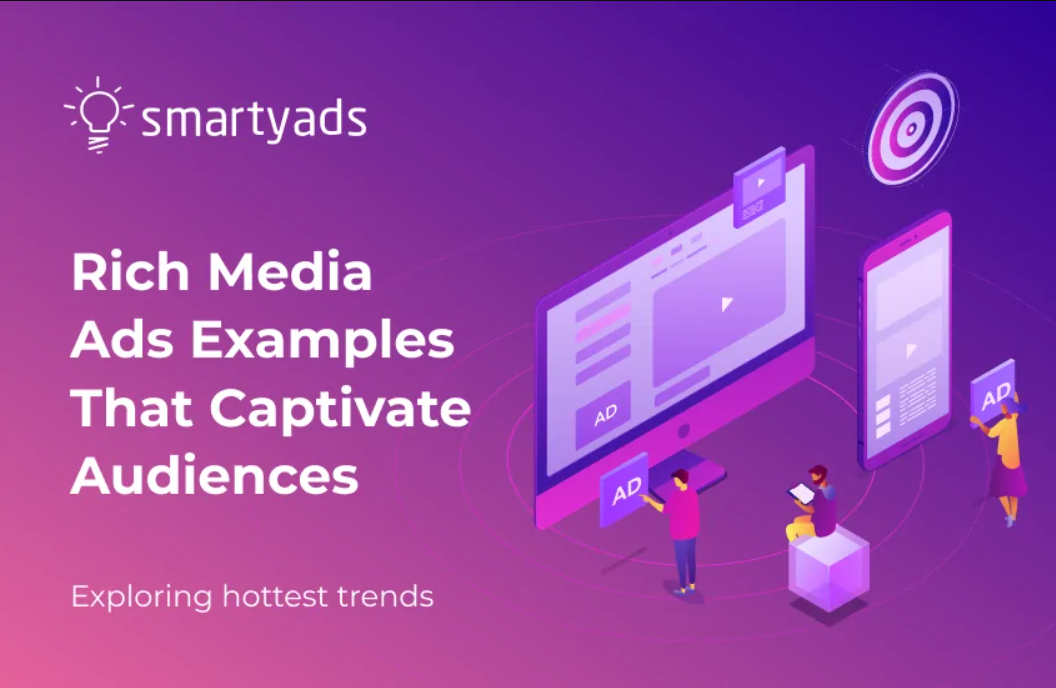
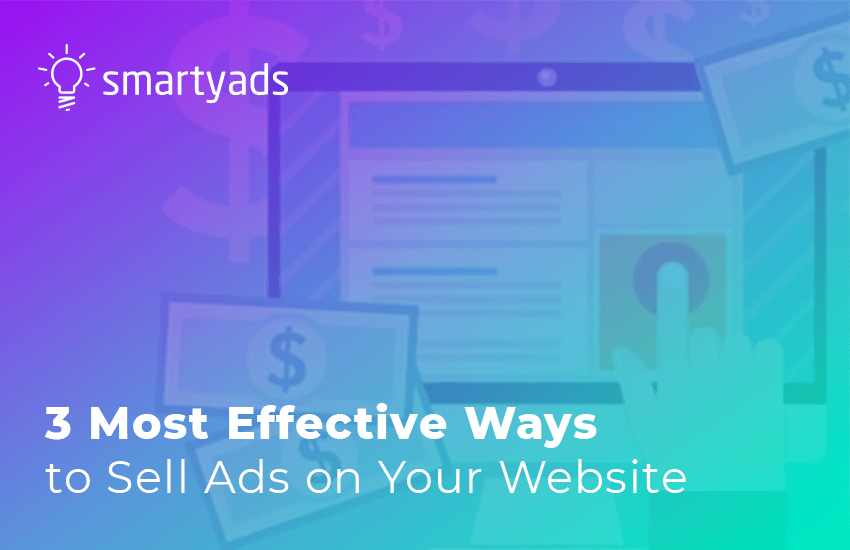

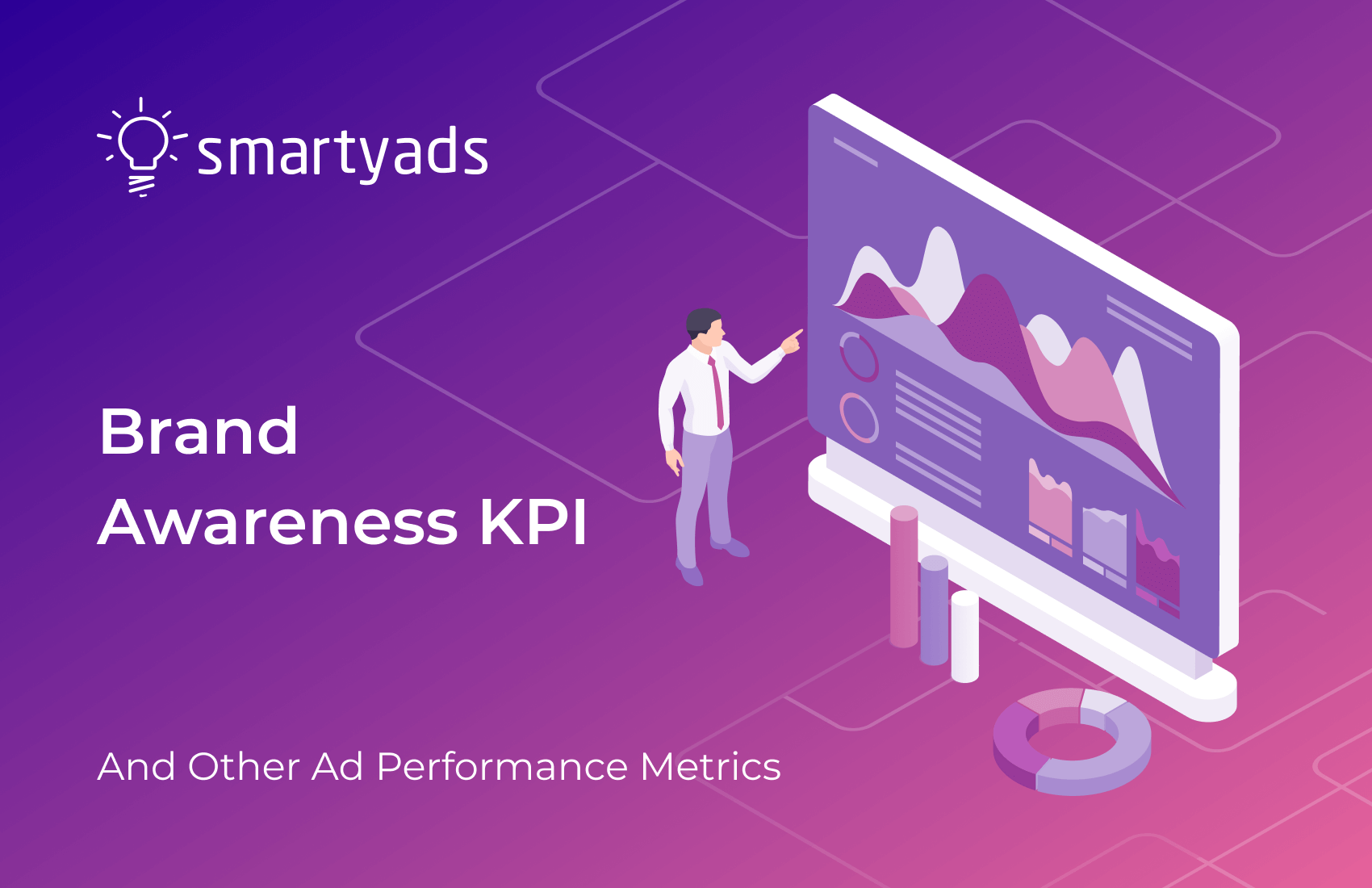
.webp)